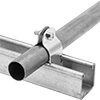Filter by
Strut Channel Type
Bracket Type
Channel Height
Strut Channel Framing Component
Construction
ID
Thickness
DFARS Specialty Metals
Export Control Classification Number (ECCN)
Width
Nut Material
Building and Machinery Hardware
Material Handling
Fabricating and Machining
Electrical










































